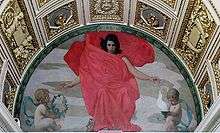Edward Simmons (painter)


Edward Emerson Simmons (October 27, 1852 – November 17, 1931) was an American Impressionist painter, remembered for his mural work. He was born in Concord, Massachusetts, the son of a Unitarian minister.
He graduated from Harvard College in 1874, and was a pupil of Lefebvre and Boulanger in Paris, where he took a gold medal. In 1894, Simmons was awarded the first commission of the Municipal Art Society, a series of murals — Justice, The Fates, and The Rights of Man for the interior of the Criminal Courthouse at 100 Centre Street in Manhattan. This court is the criminal branch of New York Supreme Court (the trial court in New York), where many New Yorkers serve on jury duty. Later Simmons decorated the Waldorf Astoria New York hotel, the Library of Congress in Washington, and the Minnesota State Capitol in Saint Paul.
In the year 1914 he travelled with Childe Hassam to view the Arizona desert paintings of the rising California artist Xavier Martinez at his Piedmont studio.
Simmons was a member of the Ten American Painters, who, as a group, seceded from the Society of American Artists. He was also considered a contributor to the style known as the American Renaissance, a movement after the American Civil War that stressed the relationship of architecture, painting, sculpture and interior design.
Simmons published his autobiography in 1922.
Gallery
 Awaiting his return, 1884, private collection
Awaiting his return, 1884, private collection The Reflection
The Reflection Girl reading 1893, private collection
Girl reading 1893, private collection Wrześniowe popołudnie, 1892
Wrześniowe popołudnie, 1892 Night
Night High Sea, 1895
High Sea, 1895 July Afternoon, 1906
July Afternoon, 1906 Boston-Public-Gardens, 1910
Boston-Public-Gardens, 1910
References
Edward Simmons, From Seven to Seventy: Memories of a Painter and a Yankee, with an Interruption by Oliver Herford. New York: Harper & Brothers, 1922.
 This article incorporates text from a publication now in the public domain: Chisholm, Hugh, ed. (1911). "article name needed". Encyclopædia Britannica (11th ed.). Cambridge University Press.
This article incorporates text from a publication now in the public domain: Chisholm, Hugh, ed. (1911). "article name needed". Encyclopædia Britannica (11th ed.). Cambridge University Press.